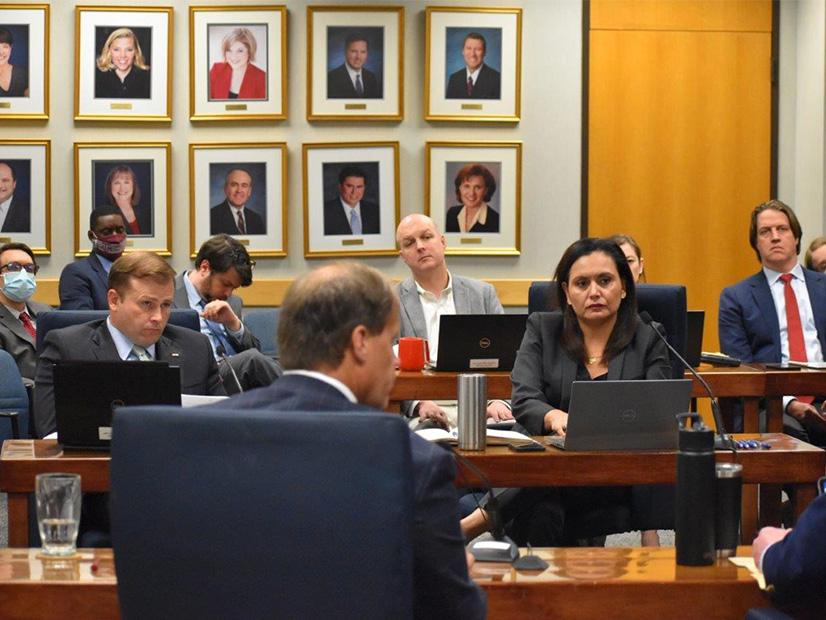
Texas regulators have settled on a two-phase blueprint to redesign the ERCOT market after a half-dozen work sessions and have given stakeholders until noon Friday to pass judgement on the proposal.
The first phase involves revisions to the operating reserve demand curve (ORDC) and additional ancillary services products. That will set the stage for the second phase, which the commissioners said will involve a load-side reliability mechanism and a backstop reliability service.
In a memo issued Monday, the Public Utility Commission of Texas said it had agreed in principle to continue pursuing the Phase 1 market design changes and has committed to developing the Phase II elements. It has requested comment on Phase II only by Friday, with stakeholders limited to five pages and an executive summary (52373).
“We can show the markets, the legislatures, our state leadership, and more importantly, the citizens of Texas, that we are continuing to make long-term reforms that will solve the problems at hand,” PUC Chair Peter Lake said during Thursday’s open meeting.
Independent consultant Alison Silverstein, who has offered her own design recommendations, said the blueprint is “unnecessary and inappropriately hurried” because the long-term proposals addressing the ERCOT system’s near-collapse during February’s winter storm will have no effect on what happens this winter.
“The electric reliability of the world’s ninth-largest economy demands thoughtful planning and careful analysis, not a rash rush to judgment with little stakeholder and no public input,” Silverstein told RTO Insider. “The commission needs to take the time to solidify and assess the impacts of the substantive measures already under way … upon operational reliability, resource revenue flows, wholesale and retail markets, and customer costs.”
Silverstein said the memo ignores one of Texas’ biggest reliability problems: that many of ERCOT’s black start units weren’t working during Winter Storm Uri.
“If Chairman Lake wants to rush something, let’s rush black start reform, please,” she said.
The various proposals’ costs have also played little part of the PUC’s discussions. The Brattle Group said last month that the load-serving entity (LSE) obligation would cost the ERCOT market an extra $300 million a year. (See Texas PUC Ponders Alternatives to LSE Obligations.)
“The LSE [obligation] … would push Texas much closer to a costly capacity market,” Stoic Energy’s Doug Lewin said. “The goal has to be to achieve high reliability at the lowest cost. Is there any analysis at all to determine what the impact will be? Or the reliability impacts? I don’t understand how the PUC could move forward without more analysis.”
‘Too Much of a Good Thing’
The commissioners did offer some pushback against the LSE obligation and other proposals during last Thursday’s latest work session, asking for more time to digest the proposals and gather stakeholder feedback.
“I want to make sure whatever we are doing to significantly modify our market is actually going to drive more dispatchable generation and maintain our existing fleet,” Commissioner Lori Cobos said. “I don’t want any unintended consequences.”
A flustered Lake responded by saying, “Lack of action has consequences, too, that can be severe.”
“While analysis and due diligence is important, action is also important,” he said. “Endless studies will not help Texans and solve our problems. I don’t want any good ideas to be sacrificed on the altar that prices can’t go up.”
The commission said the load-side reliability mechanism will be developed according to a set of principles that include offering economic rewards and providing “robust” penalties or alternative compliance payments based on a resource’s ability to meet established standards; building on ERCOT’s existing renewable energy credit (REC) trading program framework; providing a forward price signal to encourage investment in dispatchable generation; use dynamic pricing and sizing to ensure reliability needs are met without over-purchasing reserves; and mitigating market-power concerns for generation companies that also serve retail customers.
The commissioners plan to consider adopting the LSE obligation, championed by Lake since its proposal earlier this fall in a study funded by generation heavyweights NRG Energy and Exelon. The study’s authors say the LSE obligation would directly address resource adequacy concerns by introducing a formal reliability standard and a mechanism to ensure sufficient resources meet this standard. (See Study Suggests Texas LSEs Can Provide Reliability.)
The PUC will also add elements from a Lake strawman and Commissioner Will McAdams’ dispatchable energy credits (DEC) proposal. The latter recommendation would establish a dispatchable portfolio standard for certain qualifying generators to create the DECs, which would be bought, sold or traded is the same manner as RECs.
The commissioners also said they have agreed to develop a backstop reliability service that would procure accredited new and existing dispatchable resources as an insurance policy to help prevent emergency conditions. The service’s principles include non-performance penalties and clawbacks for noncompliance; deploying resources in a manner that doesn’t negatively affect real-time energy prices; and allocating costs to load based on a load-ratio share basis measured on a coincident net-peak interval basis.
In the meantime, the commission wants to modify the ORDC to reward “reliable” generation assets that can be dispatched as ERCOT’s reserve margin drops. The changes, to be effective Jan. 1, would set the minimum contingency level (MCL) at 3 GW and eventually decouple the systemwide offer cap and the value of lost load.
The PUC cut the high systemwide cap from $9,000/MWh to $5,000/MWh during last Thursday’s open meeting. (See Texas PUC Pushes 44% Reduction in ERCOT Offer Cap.)
Other products, including a firm fuel product, fast-frequency response service, ERCOT contingency reserve service and expansion of existing non-spinning reserve service already are underway.
However, that left at least one commissioner wondering whether that was too much of a good thing.
“I feel like I’m getting whiplashed with all these new products we’re creating,” Commissioner Jimmy Glotfelty said during Thursdays’ open meeting. “I almost feel like we’re creating niche markets. I hope we’re not cannibalizing our own system and we’re doing good for our market.”



